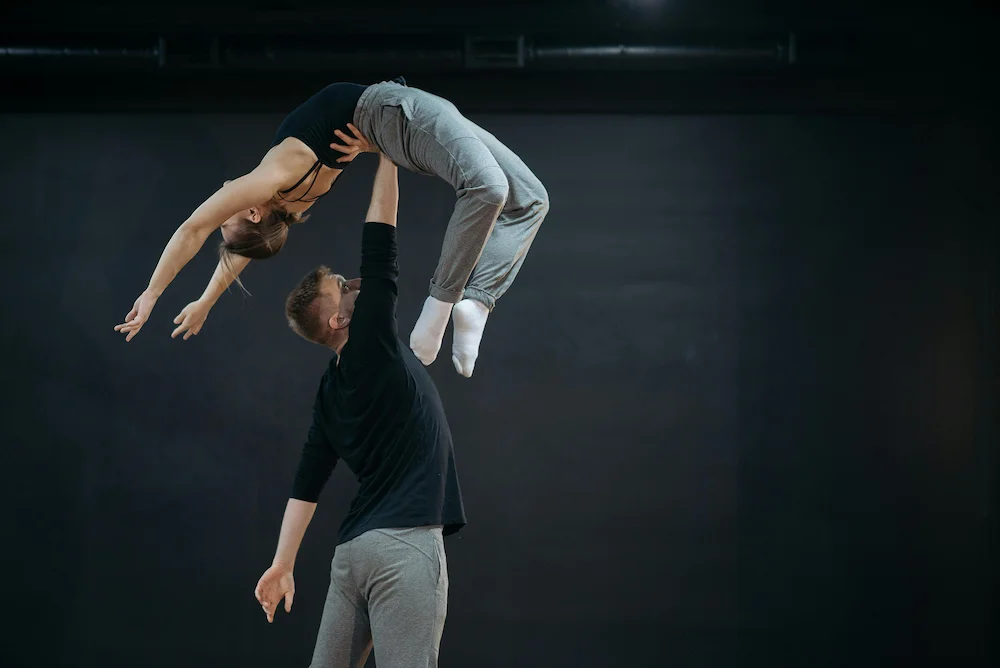What is Physical Theatre? Discover Its Impact Today
by WriteSeen
Physical theatre blends movement, dance, and mime to create narratives without words. It tells stories through the actor's body, using dynamic movement and emotion to connect with audiences.
Unlike traditional theatre, it relies on physical expression more than dialogue to captivate viewers.
Key aspects include:
- Movement and Emotion: Core elements driving the narrative.
- Ensemble Work: Performers collaborate closely to deliver powerful stories.
- Minimal Speech: Relies on physical prowess and creativity.
Explore its origin, evolution, and training tips for those fascinated by this expressive form.
The Origins and Evolution of Physical Theatre
Physical theatre is a fascinating art form, full of history and innovation. It's where performers rely on the power of movement to convey stories and emotions. Over time, this expressive mode of storytelling has evolved, drawing from diverse traditions and adapting to contemporary influences. Understanding its origins gives us insight into why it's such a compelling medium today.
Tracing Back to Ancient Traditions
Everything has its roots. For physical theatre, those roots intertwine with ancient traditions. From the vibrant and exaggerated masks of the Italian commedia dell'arte to the silent artistry of mime, past performers explored physicality as a primary narrative tool. These ancient forms paved the way for a discipline where the actor's body became an expressive canvas.
Pioneers and Innovators
Fast forward to innovators like Jacques Lecoq. He reshaped the modern landscape of physical theatre. Lecoq emphasized the significance of movement over words. By focusing on how characters express themselves physically, he empowered performers to transcend linguistic barriers. His methods encouraged a deeper connection between actors and their audiences.
Modern-Day Evolution
Today, physical theatre continues to grow and adapt. It merges with other forms like dance and circus arts, creating a vibrant tapestry that's constantly expanding. This adaptability makes it a versatile option for storytellers eager to explore beyond traditional narrative boundaries. Physical theatre's evolution has equipped it to remain a dynamic and stimulating part of the modern performing arts scene.
Physical theatre thrives on its rich history and constant evolution, offering a unique platform for storytelling.
Key Elements of Physical Theatre
Physical theatre is distinct and stands out due to its core elements. Understanding these crucial components reveals why theatre actors find it both challenging and inspiring. Each aspect requires precise attention, shaping performances that resonate deeply with audiences.
Core Elements in Motion
Physical theatre hinges on movement, space, emotion, and ensemble synergy.
- Movement: It forms the backbone of physical theatre. Performers use their bodies with precision to communicate without words.
- Space: The stage becomes an integral part of the story. Actors manipulate space to create settings and moods.
- Emotion: Transcending facial expressions, emotions permeate the actor's entire body.
- Ensemble: A unified ensemble is crucial. Actors synchronize their movements, crafting a cohesive story.
Building Skills
Actors in physical theatre must be highly versatile. They hone body awareness and control through rigorous training. Flexibility and strength are not mere assets—they're essentials.
- Leveraging these skills allows actors to convey complex narratives using actions alone.
- Physical endurance becomes key; the demanding performances test stamina and poise.
Distinguishing Physical Theatre from Traditional Theatre
Bridging movement and silence, physical theatre offers an alternative to traditional, dialogue-driven theatre. While both forms share a commitment to storytelling, they diverge in execution. This section outlines these differences and highlights how physical theatre can expand an actor's range.
Beyond Words
In traditional theatre, dialogue directs the play. Actors rely on spoken lines to relay the script. Conversely, physical theatre prioritizes movement to narrate and invoke emotion.
- Immersive Experiences: Without dialogue, physical theatre engages audiences through visual engagement. Actors transcend the traditional fourth wall, drawing viewers into their world.
- Minimalist Aesthetics: The simplicity is striking. Props and costumes are minimal, demanding that the story unfolds through physicality. This approach fosters an intimate connection, urging audiences to tune into the subtleties of body expression.
Physical theatre propels actors to discover a primal, yet powerful, form of storytelling.
Techniques and Training for Physical Theatre Actors
Training in physical theatre demands dedication. Actors enhance a broad skill set that unlocks their potential in this demanding art form. Each element of their training contributes to a more expressive and dynamic performance.
The Training Essentials
Actors immerse in various disciplines to refine their craft in physical theatre.
-
Mime Techniques: Learning the art of mime enables actors to convey complex ideas succinctly.
-
Commedia dell'arte: By studying this classic form, actors develop a grounding in exaggerated characterizations—essential for vivid expressions.
-
Etienne Decroux's Corporeal Mime: Actors focus on body articulation to communicate narrative subtleties.
Conditioning for Success
Physical theatre requires physical prowess. This training strengthens and conditions the body, ensuring actors perform with grace and endurance.
- Flexibility training enhances fluidity and range of motion.
- Strength exercises build the stamina required for lengthy, intense performances.
Acting within this space pushes the boundaries of physical expression. The skills developed extend beyond performance—granting performers versatility and resilience both on and off the stage.
Famous Physical Theatre Companies and Influential Performers
Exploring prominent companies and performers in the field of physical theatre offers insights into how this art form can captivate and inspire. They push boundaries and challenge conventions, demonstrating the powerful impact of physical storytelling.
Pioneers in Practice
Certain companies stand at the forefront of physical theatre, renowned for their distinctive approaches and groundbreaking performances.
- Complicité: Known for blending text and image, this London-based company excels in multi-layered performances.
- Théâtre de la Mezzanine: Fuses drama and movement in hypnotic displays that captivate audiences worldwide.
Inspiring Individuals
Discover influential performers whose mastery of movement has shaped and defined physical theatre.
- Marcel Marceau: Renowned as a master mime, Marceau displayed the emotional depth of silent storytelling.
- Julie Taymor: She gained fame for her innovative use of puppetry and dance, blending them seamlessly into live theatre.
These performers and groups embody the core of physical theatre, their legacy inspiring new generations of actors.
The innovation and artistry of these companies and individuals illuminate the endless potential within physical theatre.
The Role of Physical Theatre in Modern Performances
Physical theatre impacts not just traditional stage settings, but also modern adaptations across various platforms. Its influence reshapes storytelling, amplifying the visual aspects of performance art.
Expanding Influence
Contemporary performances frequently draw from physical theatre to enhance their narratives.
- Film and Television: Motion capture and elaborate choreography bring physical storytelling into cinematic and digital realms.
- Stage and Beyond: Concerts, multimedia installations, and immersive theatre borrow elements of physical expression to engage audiences.
This broad impact illustrates physical theatre's versatility, offering actors expanded opportunities to explore creative avenues.
Why Theatre Actors Should Study Physical Theatre
Physical theatre training equips actors with vital skills, enriching their repertoire with capabilities that transcend spoken dialogue. Embracing this discipline offers multifaceted benefits.
Benefits for Theatre Actors
Engaging in physical theatre provides theatre actors with a unique edge, enhancing their performance skills in significant ways.
- Enhanced Body Awareness: Actors develop an acute sense of spatial presence and physical control.
- Improved Expression: Extend emotional range by mastering non-verbal communication.
- Versatile Adaptation: Actors easily shift between various performance styles and formats.
Training in physical theatre challenges actors to push their expressive boundaries, fostering creativity and adaptability.
Resources and Opportunities for Aspiring Physical Theatre Practitioners
For those eager to delve into physical theatre, accessing resources and opportunities can be pivotal. Aspiring practitioners benefit from platforms that offer guidance, training, and connection to a global community.
Platforms for Growth
We provide an ideal space for aspiring physical theatre actors to showcase their creativity.
- Global Community: Connect with fellow performers and instructors to expand your network.
- Extensive Resources: Discover comprehensive tools for developing artistry and skillset.
- Collaboration: Engage with a worldwide community to gain fresh perspectives and insights.
By leveraging these resources, practitioners can grow and evolve their craft within an enriching environment.
Conclusion
Physical theatre offers a powerful, nonverbal approach to storytelling, using movement, expression, and ensemble work to convey emotion and meaning. It challenges actors to communicate with their entire bodies, pushing past the limits of traditional dialogue-based performance. This art form captivates audiences by transforming space, silence, and gesture into compelling narrative tools.
As explored in this guide, physical theatre draws from historic traditions while continuously evolving through innovation. From mime and commedia dell’arte to modern multimedia stages, its versatility makes it essential for performers seeking to broaden their craft. The discipline enhances body awareness, creativity, and adaptability—key traits for success in today’s theatre landscape.
Whether you're a curious beginner or a trained actor, embracing physical theatre can redefine your performance potential. Join WriteSeen to protect and share your work, connect with other theatre creatives, and grow within a global community that values expression beyond words.
TAGS

